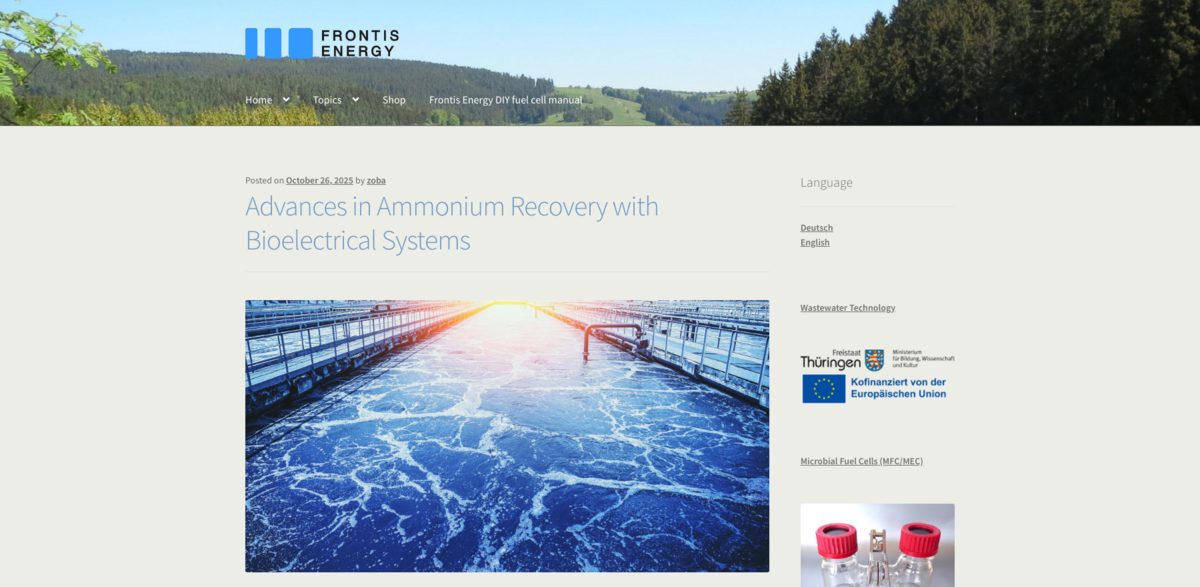What the Project Is
In recent decades, the focus of wastewater treatment has shifted from mere disposal to the recovery of valuable resources. This approach is all about harnessing energy and nutrients found in wastewater. Among emerging technologies are bioelectrical systems, which can recover not only energy and carbon but also valuable compounds like ammonium. Ammonium, a key component of fertilizers, has traditionally been produced through the highly energy-intensive Haber-Bosch process using natural gas extracted from air, a process that significantly contributes to anthropogenic CO₂ emissions and, ultimately, global warming. At the core of this innovative project lies a patented process that effectively removes ammonium from wastewater using bioelectrical systems, a technology that offers a clean, profitable, and efficient solution to the wastewater treatment challenge. It reduces waste while giving users incentives—in the form of recovered energy, nutrients, and clean water—to treat their wastewater.
Main Benefit
- Highest ammonium recovery rate of 55 g/m²/day achieved at a current of 75 mA.
- Overall ammonium removal efficiency of 97% from a 0.3% solution.
- Stainless steel electrodes operated at 1.4 V yielded a removal rate of 21 g/m²/day and a recovery rate of 17 g/m²/day.
- Enhanced cation migration due to higher current density leads to better performance.
- Long-term experiments show that higher ammonium concentration in the anolyte boosts selective ion migration and system performance.
These numbers not only highlight the technical prowess behind the process but also underline its potential to significantly reduce the operational costs associated with conventional wastewater treatment methods.
Electrogenic Microorganisms and Their Role
In bioelectrical systems, electrogenic microorganisms—or exoelectrogens—play a critical role. These anode-respiring bacteria oxidize organic matter in wastewater, transforming it into carbon dioxide and protons while using the anode as an electron acceptor instead of oxygen. It is this microbial activity, in combination with electrochemical processes, that catalyzes the necessary chemical reactions efficiently. The process is quite fascinating… the electrons flow from the anode to the cathode via an external circuit where they react with an electron acceptor. This natural yet engineered process shows immense promise, even though a comprehensive understanding of all recovery mechanisms is still a work in progress.
Cathode Dynamics and Material Considerations
The migration of ammonium ions from the anode to the cathode through a cation exchange membrane is driven by concentration gradients and the electric field. However, high-performance operations can lead to material wear at the cathode, which brings about a critical balance between operational efficiency and material durability. Researchers have explored different cathode materials and applied voltage conditions to find the optimal setup. For instance, experiments with stainless steel electrodes operated at 1.4 V demonstrated improved performance, primarily due to enhanced cation migration, resulting in rates like 21 g/m²/day removal and 17 g/m²/day recovery. The fine-tuning of materials and voltages, although challenging, is essential to maintain long-term durability and cost-effectiveness in practical applications.
Optimization Challenges and Industrial Scaling
A major challenge still lies in further optimizing these bioelectrical systems for practical and industrial use. Although promising findings have been achieved in lab-scale experiments, transitioning this technology to large-scale operations requires a deep understanding of the underlying processes. The system uses a three-chamber configuration with a hydrophobic membrane to study the effects of different electric currents and ammonium concentrations. Achieving a delicate balance between energy efficiency and material lifespan is crucial when scaling up. The detailed experiments indicate that operating at 1.4 V increases the recovery efficiency while reducing energy consumption per gram of nitrogen—making the process not only effective but also more environmentally friendly.
Research Insights and Future Perspectives
Findings from a study conducted by the Autonomous University of Barcelona have significantly advanced the understanding of the system’s performance. The study systematically examined how varying electric currents and ammonium concentrations affect recovery rates. With the optimal setup reaching a peak ammonium recovery rate of 55 g/m²/day, it emphasizes the importance of material selection and operational adjustments. Although some challenges remain, such as managing material wear at higher currents, the promising results indicate that, with further refinement, bioelectrical systems could efficiently reverse the traditional methods of fertilizer production. This research underlines that if the scaled-up process maintains long-term stability and low energy demand, it offers a truly pioneering solution for sustainable nitrogen recovery.
Project Impact
- SDG 6: Clean Water and Sanitation
- SDG 7: Affordable and Clean Energy
- SDG 12: Responsible Consumption and Production
- SDG 13: Climate Action
The project’s potential to reduce dependence on the energy-intensive Haber-Bosch process while promoting the recovery of commercially viable ammonium is a significant boon for industries looking to align with global sustainability goals.
Moving Towards a Circular Economy
By combining microbial activity with electrochemical processes, this advanced technology heralds a new era in wastewater treatment. Not only does it remove contaminants with minimal energy input, but it also transforms waste into valuable products like concentrated ammonium, which can be used as an efficient fertilizer. The elegant interplay between nature and technology highlights the future of sustainable resource recovery. The process recovers energy, cleans wastewater, and returns valuable nutrients back into the production cycle—moving closer than ever to a circular economy. While challenges remain, the momentum gained from these tests and the ongoing efforts in scaling up signal a bright future for bioelectrical wastewater treatment, where every element of waste can become a resource. This dynamic approach offers industries a cleaner, more financially attractive path forward while supporting the broader shift towards a resilient, green infrastructure.





















